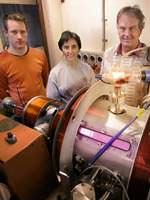
Image credit: ANU
The dream of manned missions to Mars and beyond could become a reality thanks to plasma technology developed at ANU.
Research results to be published in the journal Applied Physics Letters this week show that the ANU Helicon Double Layer Thruster (HDLT) can be powered by hydrogen ? an otherwise unusable waste product in manned spacecraft.
The HDLT uses solar electricity from the sun to create a magnetic field through which hydrogen is passed to make a beam of plasma, which powers a ship through space.
While the plasma thruster has a fraction of the power of the rockets that launch the space shuttle, it uses far less fuel and gets more thrust as a ratio of the fuel it burns, making it ideal for interplanetary missions.
“The Americans say they want to send men to Mars ? this is the technology to take them there,” said the HDLT’s inventor Dr Christine Charles.
“This thruster gives Australia a fantastic opportunity to be part of the international space race.”
The ANU team led by Professor Rod Boswell has been in close collaboration with NASA, helping US scientists fix glitches with their own plasma thruster, the Variable Specific Impulse Magnetoplasma Rocket (VASIMR) invented by veteran shuttle astronaut Franklin Chang-Diaz, who visited ANU last year.
While the technology of plasma thrusters is not new, its popularity has only taken off in recent years, with it being used to help satellites maintain their positions in orbit. However, the NASA VASIMR concept and more recently the ANU HDLT are very recent inventions which may open the door to deep space exploration.
The ANU thruster has the edge on rival technologies as it is simpler and has been proven to work with hydrogen. Importantly, it also does not emit positively charged ions that could potentially cause a disaster by interfering with a spacecraft’s communications systems.
“The HDLT is a beautiful piece of physics because it is so simple. It doesn’t need any moving parts,” Dr Charles added.
Original Source: ANU News Release
